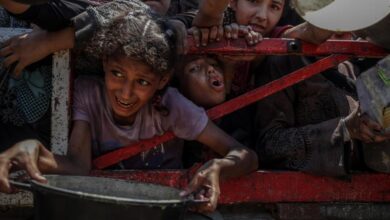DADAAB, Kenya – The dry heat beats down on the vast, arid landscape that stretches through northeastern Kenya. Torrid winds blow over sandy terrain as a sea of humanity approaches the closed gates of Dagahaley refugee camp, a facility already flooded with thousands of Somalis who have traveled hundreds of kilometers to escape arguably the worst humanitarian disaster in this region's history.
Southern Somalia is beset by a severe drought that has lasted several years. Analysts say persistent conflict in the country – which pits militants belonging to the Islamist al-Shabab group against Western-backed government forces – helped turn the crisis into famine. The United Nations claims nearly four million people currently face starvation. Poor governance and an absence of sustainable food security are also to blame for the 10 million East Africans affected in total by the drought.
Dagahaley is one of three major facilities that form Daadab refugee camp, the largest refugee camp in the world. Dadaab, located near the Somali border, was originally built to accommodate 90,000 people but now houses more than four times that amount.
"I have no doubt that in today's world, Somalia corresponds with the worst humanitarian disaster,” UNHCR chief Antonio Guterres recently told journalists. “I have never seen a refugee camp with people coming in such desperate conditions."
Inside Dagahaley, a chain of emaciated, shirtless children line up to provide personal data to aid workers. Withered with malnutrition, mothers hold crying babies. Squeals and cries of desperation fill the air.
One breast-feeding mother, Asha Hassan, who has little to offer her frail son gasping for milk, says she came here from Jubadda, a town 400km away deep into southern Somalia. Her sunken cheekbones evidence her weakness. Covering her face in a headscarf worn only by married women, she smiles briefly but says she’s been starved for days. Surrounded by hundreds of children, she weeps at the site of her parched skin peeling. According to Milhia Abdul Kadir, a physician with the non-profit organization Doctors Without Borders, this condition results from micronutrient deficiency.
Dadaab refugee camp is 100km toward the Somali border from the Kenyan frontier town Garissa. Burdened by lack of supplies and ever-increasing numbers of refugees in need, aid workers are struggling to provide for the estimated 380,000 people in the camp. New arrivals convert thickets and brush into makeshift homes that are two meters in width but house up to 10 people. Some turn UNHCR plastic bags into roofs for their shanties, attempting to provide relief from the oppressive sun.
Graves holding children unable to survive the harsh conditions are scattered about outside the camps. Sanitation conditions in the facilities are poor apart from the newly opened fourth camp, Ifo 2. Equipped with clean pit latrines, Ifo 2 also boasts schools with classrooms.
In recent years, the Kenyan government has been reluctant to open Ifo 2, citing security concerns. Speaking to journalists last week in Daadab, however, Kenyan Prime Minister Raila Odinga assured the international community that “the camp is now open to cover for the increasing influx of the fleeing refugees.”
Another refugee, Shukri Noor, sits quietly inside the Hagadera camp on a tattered piece of cloth used by women as a shawl. She says she had to make a choice to take one of her three children with her on the journey from Somalia. Noor departed with her infant child, leaving behind a 10-year-old son and a five-year-old daughter. She trekked hundreds of kilometers through bandit-filled territory with only a small portion of sorghum. Shukri says she began her journey without a target destination or plan for survival.
“I will fear no evil for Allah is with me,” she says. “Before I came here I was a successful business widow with a large herd of camel and goats back in my village. I had inherited the camels from my husband who died from bandit attacks in Jubadda.”
But in June the devastating drought and hunger caught up with Shukri’s family and she began to sell her livestock at low prices to provide her children with basic necessities. She could only fend off the crisis for so long, however.
“When we could bear no more we gathered our belongings and held our shoulders high then set forth toward south to our unknown destination,” Shukri says.
Shukri says many Somalis lost their way en route to the camps here. Others died along the way. Shukri says she witnessed more than five children die daily due to poor health and starvation. Those that partook in the journey, according to Shukri, shared the little food they had with the others. But by the 15th day of Shukri's traumatic journey, the food supply ran out.
“We took twenty one days to arrive here, and on arrival I was so weak to the point of death,” Shukri says. “My son is the one who steers me to keep hoping.”



